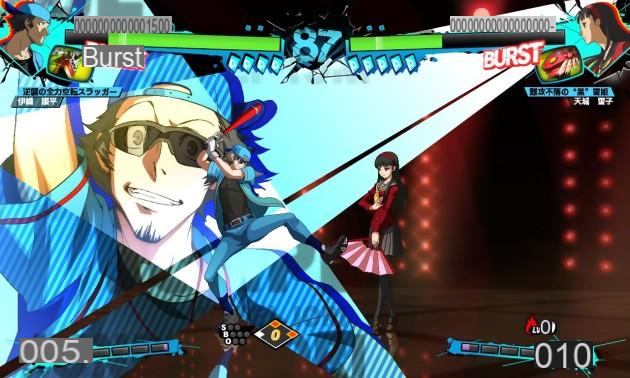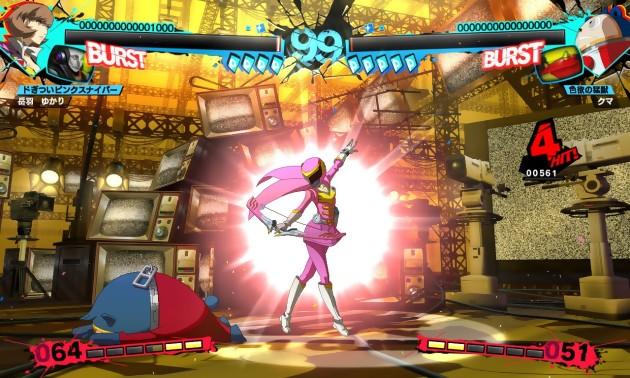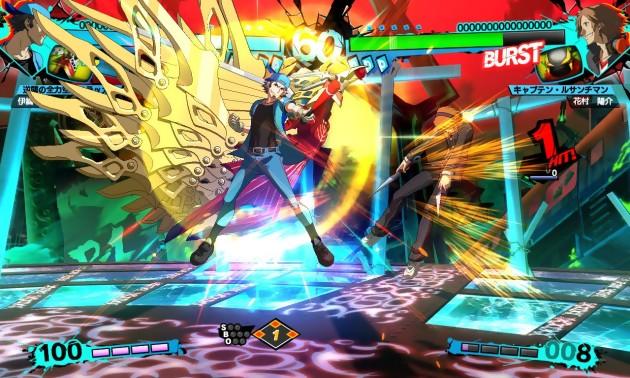Unlike Persona 4 Arena, which took nine months to come out with us, its sequel only needed three times less time to land on the Old Continent. An express localization which does not however allow to benefit from subtitles in French, one of the main defects of the original version. There is still a way to choose the Japanese voices during the clashes, an option that is unfortunately not possible when you dive into the “Story” mode. The latter picks up the story where it left off in Persona 4 Arena, with a different system from what we had seen last year. More concretely, it is a question of progressing in events specific to Persona 4 then to Persona 3, through the eyes of several characters whose destinies are closely linked; while Persona 4's predecessor Arena Ultimax featured individual, branching storylines. Despite everything, the "Story" mode remains indigestible and it is often necessary to wait long minutes before fighting. The dialogues are endless, and only fans of the Persona series may find their account. The others, meanwhile, will certainly spend more time on the "Golden Arena" mode, the concept of which resembles that of survival; except that here, each fight will improve the stats (speed, power, resistance among others) of his character as in any classic RPG. By accumulating experience points, it will also be possible to learn new skills that can be used in the middle of combat, knowing that the maximum per match has been set at four. With so many difficulty levels and an endless number of floors, there is plenty for lonely souls.
The realization in 2D continues to drool, the richness of the content always gray and the adjustments made reinforce the depth of the gameplay.
 The "Arcade" mode, much more direct, is still in order, as are the inescapable "Challenge" and "Score Attack". Obviously, Persona 4 Arena Ultimax allows neophytes to learn the basics correctly thanks to the "Training" and "Lesson" modes, with a multitude of parameters to reproduce all the situations that can be encountered, even when the connection is faulty. . Speaking of the online game precisely, it is rock solid. We have rarely been bothered by lag, and there are always people to exchange a few kindnesses in the four corners of the planet. But the most interesting thing about online matches is the lobby, which takes the form of an arcade room where you can take your avatar from one terminal to another. To put the aficionados a little more in the pocket, the developers have scattered these spaces in several places inspired by places of the Persona franchise. Fanservice to the brim, even if it is still far from the opulence of a Super Smash Bros. of emoticons. And then, we will not forget to point out the P-Cards with which we can better study the profile of the opponents – and even add them to our contact list – as well as the replays to dissect everything with a clear head. On the visual level, Persona 4 Arena Ultimax is as neat as its elder: the animations of the fighters are polished, and it's always a pleasure to see such large sprites evolve on the screen. Same thing with regard to the various effects punctuating the attacks, especially the Instant Kills which give rise to sympathetic mini-cut scenes.
The "Arcade" mode, much more direct, is still in order, as are the inescapable "Challenge" and "Score Attack". Obviously, Persona 4 Arena Ultimax allows neophytes to learn the basics correctly thanks to the "Training" and "Lesson" modes, with a multitude of parameters to reproduce all the situations that can be encountered, even when the connection is faulty. . Speaking of the online game precisely, it is rock solid. We have rarely been bothered by lag, and there are always people to exchange a few kindnesses in the four corners of the planet. But the most interesting thing about online matches is the lobby, which takes the form of an arcade room where you can take your avatar from one terminal to another. To put the aficionados a little more in the pocket, the developers have scattered these spaces in several places inspired by places of the Persona franchise. Fanservice to the brim, even if it is still far from the opulence of a Super Smash Bros. of emoticons. And then, we will not forget to point out the P-Cards with which we can better study the profile of the opponents – and even add them to our contact list – as well as the replays to dissect everything with a clear head. On the visual level, Persona 4 Arena Ultimax is as neat as its elder: the animations of the fighters are polished, and it's always a pleasure to see such large sprites evolve on the screen. Same thing with regard to the various effects punctuating the attacks, especially the Instant Kills which give rise to sympathetic mini-cut scenes.
IDEA PERSONA FOR INTERTITLE
 On the gameplay side, the developers of Arc System Works have naturally carried out a rebalancing of forces, which implies new priorities to learn. This is all the more valid for Personas that require a keen sense of timing so as not to intervene in the wind. The effectiveness of the sequences depends on it, but beginners will probably prefer auto combos – already present in Persona 4 Arena – which offer the opportunity to release a 39 hits without forcing, when the SP gauge allows it. The P combos require a little more skill, but this is again a system for those who were not born with an arcade stick in their hands. They will also be interested in the S Hold System which, when you hold Square/X, displays a gauge on the screen which allows you to trigger different attacks, whether it's a Skill Boost (the equivalent of EX attacks from Street Fighter IV), an SP Skill or an Instant Skill. By squinting, we even see that some special moves made using the S Hold System have different properties from those we usually get. In absolute terms, charging the gauge in the middle of a fight represents a high risk against a purist, but it must be recognized that the maneuver can in certain cases facilitate the opening of guard. Another innovation designed for Persona 4 Arena Ultimax: the Shadow version of the characters. This obscure version favors offensive play thanks to an SP gauge which fills up much more quickly, and which remains intact from one round to the next. That's not all, because we also have a larger vital bar, as well as Shadow Frenzy which is a kind of second state that the fighter can take advantage of.
On the gameplay side, the developers of Arc System Works have naturally carried out a rebalancing of forces, which implies new priorities to learn. This is all the more valid for Personas that require a keen sense of timing so as not to intervene in the wind. The effectiveness of the sequences depends on it, but beginners will probably prefer auto combos – already present in Persona 4 Arena – which offer the opportunity to release a 39 hits without forcing, when the SP gauge allows it. The P combos require a little more skill, but this is again a system for those who were not born with an arcade stick in their hands. They will also be interested in the S Hold System which, when you hold Square/X, displays a gauge on the screen which allows you to trigger different attacks, whether it's a Skill Boost (the equivalent of EX attacks from Street Fighter IV), an SP Skill or an Instant Skill. By squinting, we even see that some special moves made using the S Hold System have different properties from those we usually get. In absolute terms, charging the gauge in the middle of a fight represents a high risk against a purist, but it must be recognized that the maneuver can in certain cases facilitate the opening of guard. Another innovation designed for Persona 4 Arena Ultimax: the Shadow version of the characters. This obscure version favors offensive play thanks to an SP gauge which fills up much more quickly, and which remains intact from one round to the next. That's not all, because we also have a larger vital bar, as well as Shadow Frenzy which is a kind of second state that the fighter can take advantage of.
The absence of a localization in French and the indigestible "Story" mode remind us that the faults pointed out last year have also made the trip.
 Indeed, with this rage in the stomach, we can multiply Skill Boosts, SP Skills and other cancels at the speed of light, bearing in mind however that attacks that usually eat up SP reduce the time during which the Shadow Frenzy is up and running. In addition, opting for a Shadow facet has a number of disadvantages, such as the fact that the damage inflicted with classic attacks is lower. The Burst is not relevant either, in the same way as the Awakening known to confer additional power when the vital gauge turns red. Finally, to talk a bit about the cast of Persona 4 Arena Ultimax, we note that this time it is made up of 22 characters compared to only 13 in 2013. True to form, Arc System Works has ensured that they are all singular, even Shadow Labrys and Labrys which look like duplicates; a remark that can also be made to Sho Minazuki who has the particularity of walking around with and without Persona. The approach is absolutely not the same when you have a partner or not at your side, which shows that it is not mandatory to offer a hundred warriors to set up a deep game system. The new kid Junpei Iori is quite good at stalling mix-ups with his baseball bat, but his low resistance makes him a character not to be put in just any hands. Quite the opposite of Yukari Takeba who has a balanced profile and allows you to stay at a distance to catch your breath. As for Rise Kujikawa, she especially hurts a lot when she relies on her Persona.
Indeed, with this rage in the stomach, we can multiply Skill Boosts, SP Skills and other cancels at the speed of light, bearing in mind however that attacks that usually eat up SP reduce the time during which the Shadow Frenzy is up and running. In addition, opting for a Shadow facet has a number of disadvantages, such as the fact that the damage inflicted with classic attacks is lower. The Burst is not relevant either, in the same way as the Awakening known to confer additional power when the vital gauge turns red. Finally, to talk a bit about the cast of Persona 4 Arena Ultimax, we note that this time it is made up of 22 characters compared to only 13 in 2013. True to form, Arc System Works has ensured that they are all singular, even Shadow Labrys and Labrys which look like duplicates; a remark that can also be made to Sho Minazuki who has the particularity of walking around with and without Persona. The approach is absolutely not the same when you have a partner or not at your side, which shows that it is not mandatory to offer a hundred warriors to set up a deep game system. The new kid Junpei Iori is quite good at stalling mix-ups with his baseball bat, but his low resistance makes him a character not to be put in just any hands. Quite the opposite of Yukari Takeba who has a balanced profile and allows you to stay at a distance to catch your breath. As for Rise Kujikawa, she especially hurts a lot when she relies on her Persona.


























